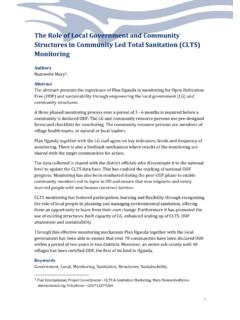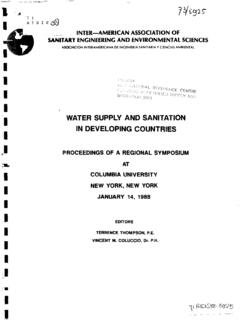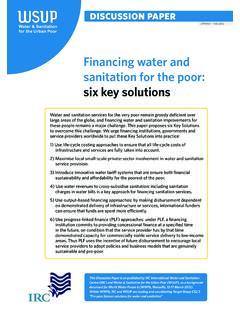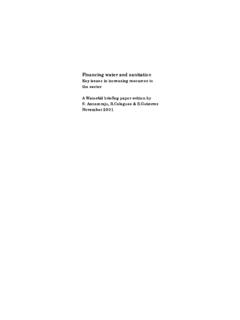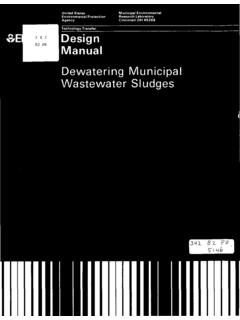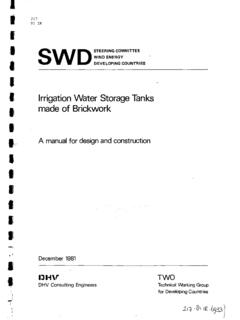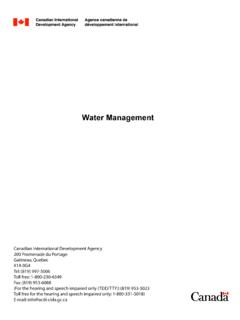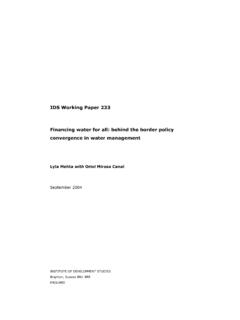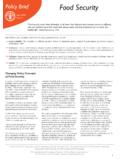Transcription of SLOW SAND FILTRATION - IRC
1 85SL. slow sand . FILTRATION . A low cost Treatment for Water Supplies in Developing Countries slow sand FILTRATION is a form of surface water treatment technology which should be considered in any situation where low cost and ease of operation and maintenance are desirable features. These criteria might equally well apply in developed and developing countries, but this booklet is primarily aimed at developing country applications because of the special circumstances and urgent needs in those countries. Published for the World Health Organization's Regional Office for Europe by the Water c _. Research Centre, UK, in collaboration with the International Reference Centre for Community JL$^ -$S<SL-U2&). Water Supply and Sanitation, The Netherlands EXECUTIVE SUMMARY. slow sand FILTRATION was the first water treatment process introduced to improve the quality of surface water in Europe and North America and soon proved to provide protection against cholera and typhoid.
2 It has remained a suitable treatment technology throughout the world and is recognised as particularly appropriate for application in developing countries by reason of the simplicity of design and construction and the ease of operation and maintenance. In areas where land is available, slow sand FILTRATION is a low-cost water treatment process which can be operated and maintained by a trained member of the local community. No other available water treatment technology, excluding disinfection, can produce as safe a drinking water and provide as great a protection of public health. Pretreatment processes for highly turbid surface waters are available and allow wider application of slow sand FILTRATION in tropical areas. Other minor disadvantages are generally outweighed by the advantages and some developing countries have already taken advantage of the technology in their water supply programmes.
3 There is still a lack of awareness of the benefits to be gained from increasing application of slow sand FILTRATION in many developing countries and the objective of this booklet is to draw attention to facts about this appropriate technology and encourage more countries to take advantage of its simplicity and low cost. THE PUBLISHING ORGANISATIONS. The Water Research Centre (WRc) is the principal organisation in the UK for research and development into all aspects of water technology. It employs about 600 staff at three locations in modern, well-equipped laboratories. WRc is a WHO. Collaborating Centre for Drinking Water and Water Pollution Control. Further information about WRc can be obtained from Water Research Centre, Henley Road, Medmenham,PO Box 16 Marlow, Bucks, SL7 2HD, England. The International Reference Centre for Community Water Supply and Sanitation (IRC) is an internationally operating, independent, non-profit making organisation dealing with information and technical support for water and sanitation improvement in Developing Countries.
4 Support is provided by means of publications, training and education, evaluation and advice, development and demonstration. Requests for further information about IRC should be sent to International Reference Centre for Community Water Supply and Sanitation, PO Box 93190, 2509 AD, The Hague, The Netherlands. slow sand . FILTRATION . A low cost Treatment for Water Supplies in Developing Countries Text written by Prof. PescodOBE. University of Newcastle-upon-Tyne, UK. in collaboration with ? - ' - - - w y , r'-;-f-oc,.,- : - f: ; - - . " ". Dr H. Abouzaid National Organisation for li.'. >'- << ' {'.<>'?. Drinking Water, Morocco and 3S^I 8 s-SI. Dr Sundaresan University of Madras, India Published for the World Health Organization's Regional Office for Europe by the Water Research Centre, UK, in collaboration with the International Reference Centre for Community Water Supply and Sanitation, The Netherlands 1.}
5 THE NEED and parasites in drinking untreated water from surface sources. Whenever safe spring or borehole water is not The Target available within reasonable distance and at a suitable A simple, low-cost water treatment system is essential depth, contaminated surface waters are normally the for widespread application in developing countries. only source of supply possible and their treatment is slow sand FILTRATION (SSF) is a form of surface water essential. slow sand FILTRATION is the simplest low-cost treatment technology which should be considered in process for surface water treatment which can provide a any situation where low cost and ease of operation and safe and acceptable drinking water comparable with maintenance are desirable features. These criteria might that produced by complex chemical coagulation/rapid equally well apply in developed and developing sand FILTRATION treatment plants.
6 In Europe and North countries but this booklet is primarily aimed at America, slow sand filters were the first treatment developing country applications because of the special applied to public water supplies and were instrumental circumstances and urgent needs in those countries. in preventing cholera and typhoid epidemics. Even today, as indicated in Chapter 6, they still make a The Global Situation significant contribution in providing the reliable water World Health Organization (WHO) statistics on water supply service which communities in developed supply provisions in developing countries clearly countries take for granted. They must now be made to indicate that many millions of people in developing play a dominant role in protecting the health of regions of the world were, in 1983, still denied a safe communities in developing countries which are and adequate water supply: increasingly being forced to draw on surface waters for their potable supply.
7 THE GLOBAL SITUATION IN 1983. Total Population Population with Water Supply WHO Region Urban Rural Urban Rural 10 1. % 103 % 103 % 103 %. Africa 100 097 25 299 332 75 61 419 61 77 548 26. Americas 257 086 67 127 385 33 219 823 86 50 532 40. Eastern Mediterranean 254 111 24 823 749 76 167 255 66 357 094 43. South-East Asia 74 136 40 111 796 60 51 995 70 51 969 46. Western Pacific 112 423 41 162 005 59 96 684 86 44 518 27. TOTAL 797 853 34 1524 267 66 597 176 75 581 661 38. Source: World Health Organization (Kef. 1). Although the International Drinking Water Supply The Unit Cost of Treatment and Sanitation Decade (IDWSSD), 1981-1990, has In countries where resources for development are focussed attention on the desirable goal of 100% water grossly inadequate, the water supply sector must supply coverage in the short-term, progress with compete for its share of available funds with other national programmes still leaves much to be desired.
8 Deserving sectors. Most National Plans now include With the huge backlog to be made up and the provisions for water supply but in few developing continuing high rate of population growth, the level of countries will allocations allow complete coverage of the investment required to attain the objective will be population with safe and adequate water supply by beyond the reach of most developing countries unless 1990, the Decade goal. Under these circumstances, the low-cost approaches are generally accepted by unit cost of providing water to communities becomes executives, planners and designers. extremely important. The lower the cost per person, the Simpler forms of technology are also more greater the number of people who will benefit from manageable where skilled technical supervision is not available resources and the sooner the total population available and this factor alone will sustain the long-term will be provided with at least basic needs.
9 Water supply performance of simple water supply systems serving executives, planners and designers who fail to take low-income communities in developing countries. More advantage of the low-cost benefit of slow sand FILTRATION advanced water systems have often been observed to will be condemning significant numbers of people to cease operating within a few years of construction, continuing exposure to waterborne diseases and where they were neither operable nor affordable by the denying them the improved quality of life which a safe recipients and the central agency had made no and adequate water supply would help to bring. provision for operation and maintenance support. Operation and Maintenance The Health Problem The reason why so many 'white elephant' water Inadequate water supply and poor sanitation account treatment plants lie derelict in developing countries is for approximately 30,000 deaths daily, many of them because the technology chosen was too sophisticated for infants, and several hundreds of millions of people are the recipient communities to operate and maintain.
10 In suffering from water-related illnesses at any one time. many cases, the cost of operating conventional Such morbidity is not only a drain on productivity in chemical treatment plants was beyond the capacity of developing countries but seriously affects the quality of low-income communities to bear without government life in general. subsidy. Adoption of slow sand FILTRATION , where Many water-borne diseases are spread through the technically feasible, will reduce operation and unavoidable ingestion of pathogenic micro-organisms maintenance costs and allow plant operators to be 2. provided by the local community. The water agency's raw surface water, and will be of better quality than technical support system will only be required for water from this source treated by rapid sand filters. general supervision, solution of major problems and However, to guarantee pathogen-free water at all times, provision of spares.

